
7250R TRACTOR
Tractor
- 250 Engine hp
- John Deere PowerTech™ 6.8L PSS
- Choice of e23™ PowerShift, or Infinitely Variable Transmission (IVT™)
- MFWD, or Triple Link Suspension Plus (TLS™)
Features
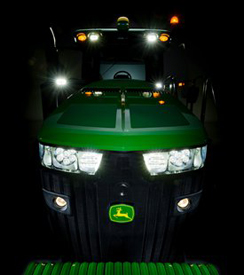 Premium lights
Premium lights
The 7R, 8R, and 8RT Series Tractors feature two lighting package options:
- Standard
- Premium
The cab lighting pattern provides 330 degrees of coverage while the hood lighting provides the remaining 30 degrees for completely programmable 360-degree, stadium-style lighting. This ensures there are no dead zones or lighting adjustments needed. The lighting configurations are available to match various applications and ensure maximum around-the-clock productivity.
Bulb housings are large, allowing for optimum total lumens and available light. The standard lighting packages use 65-W halogen bulbs, whereas the premium lighting package uses light-emitting diode (LED) lights. In the premium lighting package, these tractors take advantage of the high-performing and efficient LED technology.
The low- and high-beam driving/work lights are adjustable. Please refer to the electrical section in the operator’s manual for complete details on adjusting lights.
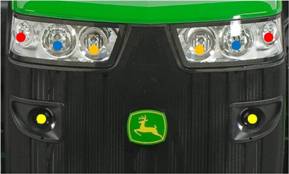 7R/8R/8RT lighting
7R/8R/8RT lighting
Yellow circles
- All lighting packages: 65-W halogen: road low beam
Red circles
- Standard: 65-W halogen
- Premium: LED
Blue circles
- Standard: 65-W halogen; field and road high beams
- Premium: LED
Orange circles
- Standard: blank
- Premium: LED
|
Standard lighting
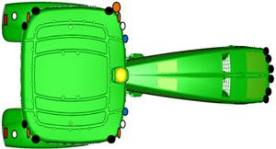 Standard lighting (8R)
Standard lighting (8R) Standard lighting (7R)
Standard lighting (7R)Six front grill-mounted lights:
- Two 65-W low-beam driving/work lights (mid grill screen)
- Two 65-W high-beam driving/work lights (top of grill screen, hood mounted)
- Two front corner-facing halogen work lights (top of grill screen, hood mounted)
10 cab roof-mounted lights:
- Two rear-facing 65-W floodlights
- Four side-facing 65-W floodlights
- Four corner-facing amber lights
Other lights:
- Two rear fender-mounted floodlights
- Two rear turn signal and brake/tail lights (fender mounted)
- Two folding-extremity lights
Plus these lights:
- Two adjustable front roof 65-W halogen floodlights
- Two front belt-line floodlights
- Rotary beacon light
Premium lighting
Eight front grill-mounted lights:
- Two 65-W low-beam halogen driving/work lights (mid grill screen)
- Two LED high-beam driving/work lights (top of grill screen, hood mounted)
- Two front corner-facing LED work lights (top of grill screen, hood mounted)
- Two front-facing LED working lights (top of grill screen, hood mounted, inner position on the sides)
12 cab roof-mounted lights:
- Four side-facing LED lights
- Four corner-facing amber lights
- Two rear-facing LED lights
- Two adjustable front roof LED lights
Other lights:
- Two rear fender-mounted LED lights
- Two rear turn signal and brake lights (fender mounted)
- Two folding-extremity lights
- Two front belt-line LED floodlights
- Rotary beacon light
The premium lighting package replaces all previous halogen and HID lights with LED lights. The only lights that are not LED are the low-beam driving lights, they remain halogen. This allows each LED light to work at a lower temperature and no one light works harder than any other. The uniformity in LED coverage allows only one type of light output surrounding the tractor.
The lighting pattern in the premium package provides industry-leading performance in nighttime visibility. LED bulbs provide maximum brightness and a true color output for excellent field definition that is easy on the operator's eyes.
The LED lights provide 40 percent greater coverage width and 10 percent more light coverage in the rear. LED lighting packages use 45 percent less amps than standard halogen lights and have an increased life expectancy over HID lights which leads to lower costs of ownership over the life of the tractor.
NOTE: Lighting packages may vary depending on region.
Selecting a lighting mode/programmable lighting
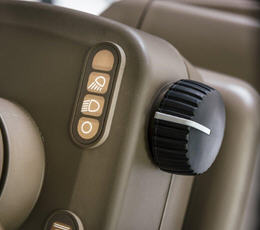 Lighting mode selector
Lighting mode selector 
Operators can quickly select a lighting mode on the steering console:
- Lights, off position
- Road lights
- Field lights
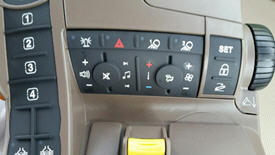 The CommandCenter™ display
The CommandCenter™ displayThe CommandCenter display allows operators to customize light settings. Operators can select only the lights they need or want for a given application and store these settings. The operator-programmed configurations can then be turned on or off with the push of a button on the CommandARM™ controls.
- Programmable field lights 1
- Programmable field lights 2
- Beacon light
- Emergency flashers
NOTE: Road/loader lights are also referred to as high-mounted driving lights for use in front hitch applications that obscure the headlights. See the Attachments section.
The battery power saver feature is also standard. When the engine is off and the outside lights have been left on, this feature is designed to avoid battery run down.
After the lights have been left on for 30 minutes and the key is in the off position, the lights cycle or blink on and off five times as an alert. The lights continue to illuminate for one more minute and then automatically shut off to protect the battery.
Field-installed options
Field-installed options are also available. To find this information, use the Build Your own Configurator application for US/Canada or Build & Price in John Deere Sales Centre for Australia/NZ.
Programmable exit lighting
Another feature is programmable exit lighting. Exit lighting allows the lights outside the cab to stay on for up to 300 seconds. They can be programmed in increments from 0 to 300 seconds.
Refer to the operator’s manual for complete instructions on programming field, driving, and exit lighting.
| Option code | Description |
| 7201 | Standard lighting |
| 7206 | Premium lighting |
The steering system uses load sensing of hydraulic pressure required to efficiently complete the designated tasks. The pressure- and flow- compensating pump produces excellent stationary or creeping ground speed steering response to handle demanding applications.
ActiveCommand Steering (ACS™)
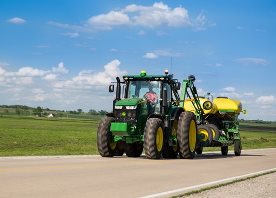 7R in transport
7R in transport
With ACS, John Deere has designed one of the most robust and full-encompassing steering system in the industry. Whether in the field or on the road, ACS reduces steering effort, which can result in reduced operator fatigue and can improve operator comfort.
There are four key features of the ACS system:
Dynamic road wheel offset
- A gyroscope senses tractor yaw and can automatically make small steering adjustments to provide unprecedented line-holding abilities. Drive down a bumpy road and experience how ACS makes it easier to keep the tractor straight, even over rough terrain. ACS delivers the ultimate in comfort.
- ACS works to prevent oversteering when a sudden obstacle causes the operator to make a quick steering reaction.
Variable ratio steering
- Approximately 3.5 turns lock to lock at in-field speeds for quick headland turns.
- Approximately 5 turns lock to lock at transport speeds.
Elimination of steering slop and hand wheel drift
- Steering wheel drift and slop are eliminated with the ACS electronic control system.
Variable effort steering
- Steering wheel resistance automatically changes with ground speed to deliver light steering effort at slower speeds for less effort during headland turns, and higher steering wheel torque at transport speeds for better operator comfort.
A fail operational system
The ACS system is fail operational, which means steering is still functional in the event of any single-point failure. John Deere has gone to great lengths to help ensure the operator can steer the tractor if something goes wrong in the steering system.
For example, if the primary controller fails, a second controller takes over. If power from the alternator is lost, the battery resumes control. If the engine quits running and is unable to supply hydraulic oil to the system, an electric-driven backup pump is used to supply the oil.
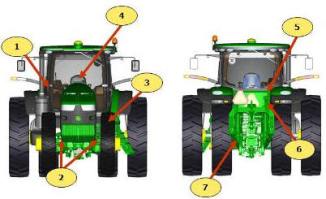 ACS components
ACS components
The ACS system consists of several key components:
- Gyroscope: this is used to measure the yaw rate (turn rate) of the tractor during transport speeds.
- Road-wheel angle sensors: these sensors simply measure the steer angle of the tractor.
- Power supply module: this module distributes the power of the battery and alternator throughout the ACS system.
- Hand-wheel angle sensors and tactile feedback unit: this includes the steering wheel position sensors and a brake, which can increase or decrease resistance dependent on speed. Lighter feedback is desired during normal field use, and slightly heavier feedback is desired during transport and while the tractor is cornering at high speeds.
- Controllers: two controllers are located in the back of the tractor and are the brains of the system.
- Control valves: also known as steering valves, control valves are used to steer the tractor.
- Electric-drive backup pump: this pump supplies oil to the steering system, brakes, and park brakes (for towing) if there is no longer a sufficient oil supply to the steering and brakes.
Value of ACS
- Improves line holding when driving at transport speeds
- Fewer turns lock-to-lock: 3.5 turns lock-to-lock in the field for quicker headland turns and 5 turns lock-to-lock at transport speeds
- Eliminates hand-wheel backlash and drift
- Reduces steering effort, resulting in reduced operator fatigue
- Smaller hand-wheel diameter for improved operator comfort and visibility
- Maintains operator feel and touch points of traditional steering column system
- Fully integrates with AutoTrac™ guidance system
- Compatible with suspended and non-suspended front axles
- Compatible with wide- and narrow-section width tires
| Option code | Description |
| 1833 | John Deere ActiveCommand Steering (ACS) |
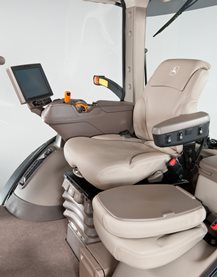 ActiveSeat and controls
ActiveSeat and controls
John Deere’s ActiveSeat utilizes electrohydraulic technology in combination with air suspension, providing the operator with enhanced ride quality over standard air-suspension seats.
Operator movements are monitored in order to reduce vertical movement. An ActiveSeat suspension can isolate the operator from up to 90 percent of vertical movements typically seen in tractor applications.
The system uses a hydraulic cylinder that is connected to a control valve assembly. Electrohydraulic valves located in the control valve assembly automatically react to inputs from two sensors, a position sensor and an accelerometer. Inputs from these two sensors control oil flow from the tractor to the hydraulic cylinder to reduce the vertical movement of the operator.
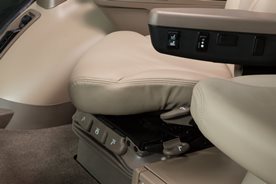 ActiveSeat left armrest
ActiveSeat left armrest
The John Deere ActiveSeat has many of the same features of the ComfortCommand™ seat with the addition of a ride firmness switch. The ride firmness switch is located on the left-hand armrest and replaces the suspension shock-dampening seat attenuation lever on the front right-hand side of the ComfortCommand seat controls.
The ride firmness switch has three positions: plus, minus, and mid position. The three positions provide three different levels of seat performance:
- The plus position provides the greatest degree of ride firmness. This position allows more of the tractor's inputs to be felt by the operator (slightly rougher ride).
- The minus position provides the least degree of ride firmness, allowing minimal tractor inputs to reach the operator, resulting in maximum seat performance.
- The mid position allows a balance between the plus (+) and minus (-) settings.
The ActiveSeat is also available as a heated leather seat for increased comfort and easier cleaning. For tractor applications where operating speed is not limited by the implement, the ActiveSeat can allow for faster field speeds and increased overall comfort and productivity.
NOTE: The John Deere ActiveSeat is not available on track tractors.
| Option code | Description |
| 2061 | Premium CommandView III Cab with Active Seat |
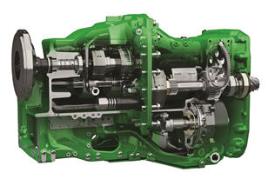 7R e23 transmission
7R e23 transmission
The e23 transmission delivers smooth shifting and intuitive controls with Efficiency Manager™ feature in a reliable 23-speed PowerShift™ transmission. The e23 transmission is available for all 7R, 8R, and 8RT Series Tractors.
The e23 has evolved from more than 50 years of John Deere PowerShift technology. With more automatic features, the e23 is easy to operate for all levels of operator experience. For more advanced operators looking to customize the transmission to best fit their operation, the e23 offers a custom mode.
As the next generation of PowerShift technology, e23 delivers the strength to handle sudden, high-torque power loads while maintaining responsive, quick, and smooth shifts. The e23 with Efficiency Manager provides improved fluid efficiency and overall productivity with limited input from the operator.
e23 options
- e23 transmission 42 km/h (26 mph) with Efficiency Manager
- e23 transmission 50 km/h (31 mph) with Efficiency Manager
Even gear spacing for optimal performance
The e23 has 23 forward gears and 11 reverse gears, which are all evenly spaced. Forward gears are spaced 15 percent apart, while reverse gears are spaced approximately 30 percent apart, providing operators smooth shifting between gears. Even spacing improves efficiency and allows for smooth, automated shifts when using Efficiency Manager. The e23 can reach maximum forward ground speed in gear F20. As a result, gears F21-F23 maintain maximum ground speed at reduced engine rpms to save fuel.
e23 controls
The e23 is available with either a right-hand or left-hand reverser.
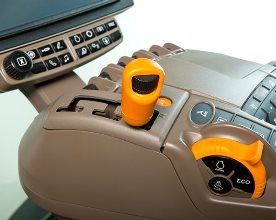 Right-hand reverser
Right-hand reverser
Right-hand reverser
A convenient, right-hand reverser is available with the e23 transmission. The reverser is located on the CommandARM™ as shown above.
- Forward direction selector
- Reverse direction selector
- Neutral position
- Electronic park lock
Right-hand reverser equipped models use three main controls to operate the tractor:
- Foot brake with integrated AutoClutch
- Set speed adjuster
- Gear selector control lever with integrated reverser
The right-hand reverser control strategy combines speed control and direction control into one multi-function lever that is conveniently located on the CommandARM. This is a good choice for most common field applications since tractor speed and direction are not constantly being adjusted by the operator.
Left-hand reverser
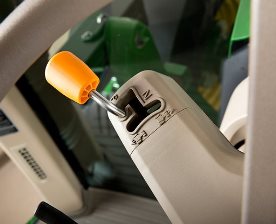 Left-hand reverser
Left-hand reverser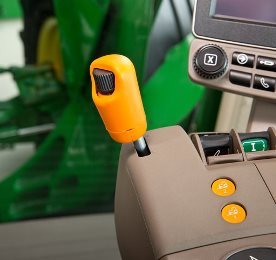 Left-hand transmission lever
Left-hand transmission leverAn easy-to-use left-hand reverser is available with the e23 transmission and includes the same functions as the right-hand reverser. The reverser control is located at the 10 o’clock position on the steering column for intuitive control.
The five-position, left-hand reverser column incorporates the following controls:
- Forward direction selector
- Reverse direction selector
- Neutral position
- Electronic park lock
Left-hand reverser equipped models use four main controls to operate the tractor:
- Foot brake with integrated AutoClutch™ function
- Set speed adjuster
- Gear selector control
- Multi-function left-hand reverser
The left-hand reverser control strategy separates the direction control lever from the speed/gear control lever on the CommandARM. This strategy is a good choice for operations requiring the right hand to run multiple operations on the CommandARM or applications requiring constant directional changes like loader work.
Determining which reverser is best suited for a specific operator depends on a few key factors. Consider the following to help choose between a left- or right-hand reverser.
- Operator preference and ergonomic benefits.
- Operators in loader applications might prefer a left-hand reverser since direction changes occur frequently while their hands are on the steering wheel (near the left-hand reverser location).
Producers primarily in row-crop applications using features like AutoTrac™ assisted steering system or operating with the seat swiveled to the right for easy access to monitors and displays might find the right-hand reverser more convenient. Speed and directional controls are in one location on the CommandARM.
Foot brake with integrated AutoClutch function
The electrohydraulically controlled brakes on e23-equipped tractors have an integrated AutoClutch function.
- At low idle only, the tractor will stop by depressing only one brake pedal.
- Pressing both brakes (locked together) simultaneously will stop the tractor from any ground or engine speed.
Braking can be done on flat ground or steep slopes simply by using the brake pedals; it is not necessary to depress the clutch.
- It is recommended to lock the brake pedals together when operating on roads.
 |
| Foot brake with integrated AutoClutch |
AutoClutch sensitivity can be adjusted through the Generation 4 CommandCenter™ display. AutoClutch can be deactivated on e23 transmissions as well; however, it will be reactivated after every key start.
Custom mode
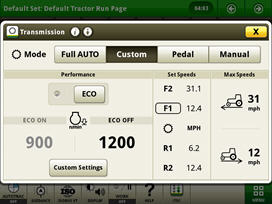 e23 custom transmission page
e23 custom transmission page
Custom mode allows operators to adjust operating parameters to meet their specific operation. Just like full AUTO mode, custom mode shifts set speeds meaning the transmission may not necessarily shift gears each time the lever is bumped. Efficiency manager is engaged automatically in custom mode.

Stopping the tractor using AutoClutch
During transport, it may be desirable to use the AutoClutch feature to stop the tractor when approaching an intersection or turn. Braking the tractor using the AutoClutch at high ground speed and engine speed will require high brake-pedal force.
Rather than using AutoClutch alone, reduce the engine rpm and reduce the e23 to a slower commanded speed before applying the AutoClutch. This will help to reduce the force needed to stop the tractor with the AutoClutch. The tractor will accelerate to the previously commanded speed upon release of the AutoClutch, repositioning of the hand throttle and increasing the commanded speed.
NOTE: The preferred method of stopping heavy towed loads is to reduce the e23 commanded speed and lower engine rpm first, and then depress both brake pedals. (Brake pedals should be locked together.)
Using individual brake pedals - implement hook-up
Individual brake pedals can be used to assist slow-speed off-road turning, such as hooking up to an implement. At low idle, the AutoClutch feature will stop the tractor if the operator depresses only one brake pedal.
To assist in hooking up an implement, depress either brake pedal while slowly increasing engine speed until the desired turn is achieved. Returning engine speed to a low idle while continuing to depress one brake pedal will slow the tractor to a stop.
CommandCenter™ controls
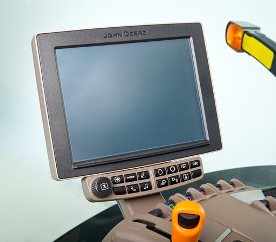 254-mm (10 in.) Generation 4 CommandCenter
254-mm (10 in.) Generation 4 CommandCenter
The CommandCenter is the central information system for tractors and allows the operator to program various settings tailored to a specific operation.
To access the tractor’s transmission settings, press the transmission shortcut button on the CommandCenter shortcut bar.
 |
| CommandCenter transmission shortcut button |
Operating modes
The e23 application settings employ three modes to take full advantage of the engine-transmission communication: full auto mode, custom mode, and manual mode.
Full auto mode
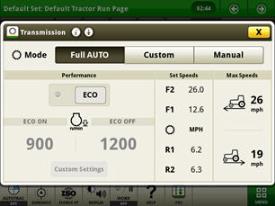 Full auto main page
Full auto main page
Full AUTO mode enables the tractor to make adjustments to the transmission operating mode automatically, based on engine and transmission speed and the load on the tractor. This means the tractor will shift up and throttle back automatically to reach the desired ground speed efficiently. Operators have the ability to set the maximum forward and reverse speeds for the tractor in their particular application.
When shifting in full AUTO mode, the transmission shifts set speeds, meaning the transmission may not necessarily shift gears each time the lever is bumped. Efficiency Manager is automatically engaged while operating in full AUTO mode. As a result, shifting will not take the tractor out of Efficiency Manager in full AUTO mode.
Advanced transmission settings
Additional transmission settings can be customized to the operators’ specific desires.
AutoClutch sensitivity can be adjusted on the transmission settings page in the CommandCenter display. Operators can turn off AutoClutch or choose from high, medium, or low sensitivity. Operators can fine-tune AutoClutch by delaying the response time, based on load, travel speed, etcetera. This allows the trailer brakes to be applied before AutoClutch engages.
- High: for light or no trailer (load) – factory default
- Medium: for medium trailers (load)
- Low: for heavy trailers (load)
- AutoClutch Off: to operate e23 just like a traditional powershift
The AutoClutch sensitivity factory default-setting is set to high, which supports most operations.
AutoClutch sensitivity settings are available in all three modes – auto, custom, and manual.
Efficiency manager
 |
| Set speed buttons and set speed adjuster |
Efficiency manager is automatically enabled in full AUTO and custom mode. Efficiency manager can be turned on in manual mode by selecting the set speed one or two on the CommandARM. The set speed adjuster on the top of the single-lever gear selector allows the operator to dial in the desired ground speed to establish set speed one or two in Efficiency Manager.
Efficiency manager allows the transmission to up or down shift and change engine rpm to maintain the set wheel speed. To reach the desired set speed, the throttle must be set to full engine rpm. This allows efficiency manager to shift the transmission and adjust engine speed to maintain the desired wheel speed. For more information on Efficiency Manager refer to the operator’s manual.
e23 operation
Both right-hand reverser and left-hand reverser control options provide full powershifts for on-the-go shifting; no need to stop or clutch when bump shifting or shuttle shifting between forward and reverse.
The single-lever shifter allows for quick and convenient shifting with minimal physical effort.
Shifts are made either by bumping the lever or by holding the lever in a forward or rearward position.
- Transmission is in neutral when the shift control or left-hand reverser is not in park, forward, or reverse.
- Operator presence feature prevents the transmission from going into gear when the operator is not seated or has the brake or clutch pedal depressed.
- Transmission can be programmed to start in 1F – 13F or 1R – 6R.
A forward gear between 1F and 13F may be preselected by depressing the clutch pedal and pushing or pulling the shift lever. The transmission will then start in the preselected forward gear when clutch pedal is released.
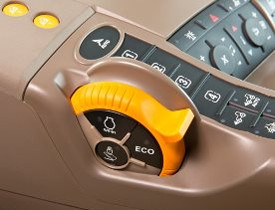 Eco button
Eco button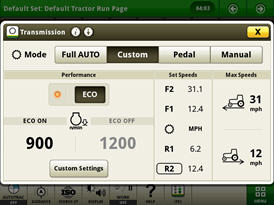 Display screen
Display screenIn custom mode, eco allows two minimum engine speeds to be set. Operators can turn eco on and off by either pushing the eco button on the side of the throttle or by selecting eco in the transmission settings page of the CommandCenter. For example, operators may choose to turn eco on during transport to utilize a lower minimum engine speed and then turn eco off while operating in the field where a higher minimum engine speed is desired.
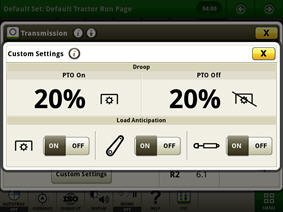 Custom settings page
Custom settings page
In the advanced settings page, operators can customize the auto shift engine speed droop as a percentage of the full engine speed. In addition, the load anticipation feature can be enabled for the hitch engagement, hydraulic engagement, or both.
Manual mode
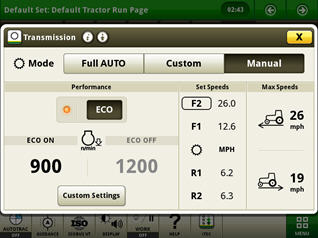 Manual mode page
Manual mode page
Manual mode operates similar to a traditional PowerShift transmission. When shifting, the transmission shifts gears, not set speeds like full AUTO and custom mode. Manual mode also features efficiency manager when the operator engages set speed one or two on the CommandARM, as shown above in illustration.
When operating in manual mode with efficiency manager active, there is the option of turning eco on or eco off. This allows the operator to select two different minimum engine speeds. In the advanced settings page, operators can adjust auto shift engine speed droop and load anticipation, similar to custom mode.
 Cornerpost display
Cornerpost display
The cornerpost display shows the commanded gear instantaneously once selected.
| Option code | Description |
| 1493 | e23 Transmission 42 km/h (26 mph) with Efficiency Manager |
| 1494 | e23 Transmission 50 km/h (31 mph) with Efficiency Manager |
| 2701 | Right-hand Reverser Bump-Shift-Type Transmission Controls |
| 2702 | Left-hand Reverser Bump-Shift-Type Transmission Controls |
Rapid shifting
 Rapid shifting
Rapid shifting
When the tractor is working in a light-load condition, for example in transport, the transmission can be shifted rapidly by bumping the shift lever.
To reach transport speeds quickly:
- Depress clutch pedal and rapidly bump shift lever to 13F
- Transmission will shift directly to 13F when clutch pedal is released
- Transmission will skip some gears as it keeps up with the operator’s command, allowing the tractor to accelerate to transport speed quickly
- Once tractor is underway in 13F, bump the shift lever to reach desired ground speed
Double shifting
The transmission can skip a gear when operating under load by double bumping the shift lever.
- This aids the ease of deceleration/acceleration when approaching and departing headland turns.
Ground speed matching
When the tractor is slowing down and the clutch pedal is depressed, the transmission will match a gear to the ground speed of the tractor when the clutch is released. Ground speed matching only engages in gears 13F higher.
Setting start-up gears
The transmission defaults to 8F and 3R at start-up. However, these default start-up gears can be adjusted from 1-13F and 1-6R through the CommandCenter. Refer to the operator’s manual for additional information.
 |
| Start-up gears in advanced settings |
Releasing the park brake
The e23 transmission utilizes a spring-engaged/hydraulically-disengaged park brake. The park brake control feature prevents accidental park brake engagement when tractor is moving at high speed.
On tractors equipped with air brakes, the park brake automatically activates the air brake system.
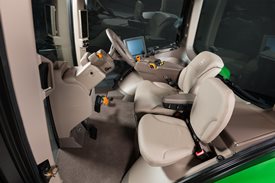 CommandView III cab
CommandView III cabThe Standard CommandView III cab offers unsurpassed visibility, operator comfort, control placement, and ride and sound quality.
Features:
- ComfortCommand™ seat with air suspension, lumbar support, swivel, fore-aft and lateral attenuation, backrest angle adjustment, adjustable left-hand armrest, and 40-degree right-hand seat swivel
- Operator presence system that warns if the operator is out of the seat while operating key functions
- Folding instructional seat
- CommandARM™ console with integrated controls
- 4100 or 4600 Generation 4 CommandCenter™ display
- Behind-the-seat storage
- Left-hand storage compartment
- Passive noise reduction system
- Service ADVISOR™ data port
- Tilt/telescoping steering wheel with position memory
- Swing-out rear window that opens 30 degrees
- Right- and left-outside mirrors (manually adjustable mirror head)
- Monitor mounts on right-hand front post and rear cab post
- Standard radio package, including AM/FM stereo and weatherband with remote controls, auxiliary input jack, four speakers, and an external antenna
- Laminated glass
- Air conditioner and heater with automatic temperature controls (ATC)
- Two 12-V convenience outlet (cigarette lighter style)
- One 12-V three-pin outlet with adapter (provides switched and unswitched power)
- One International Organization for Standardization (ISO) nine-pin connector
- Power strip with convenience plug adapter
- Hitch control lever lock and selective control lever lock
- Two-speed and intermittent front and rear wiper with washer
- Front pull-down sunshade
- Digital cornerpost display with:
- Fuel level gauge, including low fuel warning
- Temperature gauge
- Diesel exhaust fluid (DEF) gauge, including low DEF warning
- Engine rpm
- Transmission commanded gear or speed
- Vehicle system functions, such as iTEC™ system, that are operating
- Inside-mounted rearview mirror
- Beverage holders sized to accommodate various containers
- Interior left-hand dome light
ComfortCommand seat
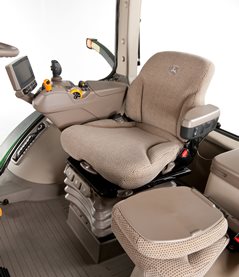 ComfortCommand seat
ComfortCommand seatComfortCommand seat improves ride quality and helps to reduce operator fatigue.
Features include:
- Armrests, lumbar support, and backrest angle are easily adjusted to match operator preference.
- Shock absorbers dampen the motion effect of the tractor for an improved ride.
- Seat height adjustments are conveniently located on the left armrest.
- Fore-aft adjustment is easy to reach located on the left front of the seat.
- Swivel adjustment, located on the front of the seat, allows the seat to be swiveled 40 degrees to the right or eight degrees to the left of the center position.
- Operator presence switch warns if the operator is out of the seat while operating key functions.
- Seat belt retractor.
- Centered cab seat provides excellent over-shoulder visibility.
- Adjustable shock absorber permits ride adjustment from soft to firm to match the operator's desired comfort level.
- Removable cushions allow for easy cleaning.
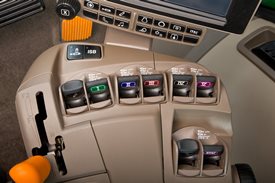 Fingertip paddle pots
Fingertip paddle pots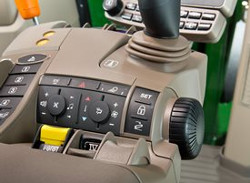 Encoder wheel
Encoder wheelCommandARM
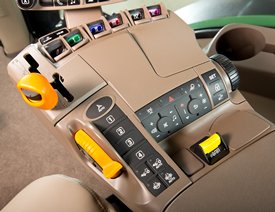 CommandARM controls
CommandARM controlsJohn Deere 7R and 8R Series Tractors feature the CommandARM with integrated Generation 4 CommandCenter display. The control layout of the CommandARM utilizes a clean and efficient design which groups controls by function and builds upon John Deere’s history of intuitive and ergonomic control placement and operation. The design of the CommandARM allows for a 40 degree right seat swivel and adjustable positioning matching the operator’s preference.
Controls located on the CommandARM include:
- Engine throttle
- FieldCruise™ system
- Minimum engine speed – CommandQuad™ transmission, 16-speed PowerShift™ transmission (PST), e23™ transmission
- Eco mode – Infinitely Variable Transmission (IVT™)
- Foot pedal lock (if equipped)
- Transmission control
- Hitch/selective control valve (SCV) controls
- Rotary encoder hitch control
- Power take-off (PTO) controls
- Mechanical front-wheel drive (MFWD) on/automatic
- Differential lock on/automatic
- iTEC sequence switches
- AutoTrac™ assisted steering system resume switch (if equipped)
- Joystick (if equipped)
- Radio
- Beacon light on/off
- Hazard lights on/off
- Field lights 1/2
- Heating, ventilation, air conditioning (HVAC) system
Transmission controls
John Deere 7R Series Tractors with CommandQuad transmissions feature a left-hand reverser. 8R Series Tractors equipped with 16-speed PST are equipped with right-hand reverser. 7R Series Tractors equipped with e23 PST offer a left- or right-hand reverser. 7R or 8R Series Tractors equipped with AutoPowr™/IVT transmissions are offered with either a left-hand or a right-hand reverser.
The transmission control lever is placed on the left side of the CommandARM closest to the operator for convenient setting and adjustment.
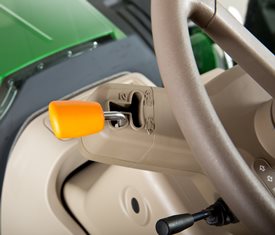 Left-hand CommandQuad/e23 reverser
Left-hand CommandQuad/e23 reverser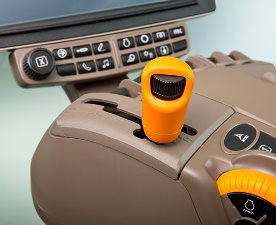 Right-hand IVT and PST reverser
Right-hand IVT and PST reverser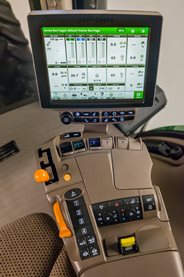 16-speed PST right-hand reverser
16-speed PST right-hand reverserHydraulic and hitch controls
Hydraulic and hitch controls utilize fingertip paddle pots for raise/lower and extend/retract functions. An optional crossgate joystick replaces fingertip paddle pots for control of SCVs and allows for programmable hydraulic functionality according to operator preference. Rear hitch position can also be controlled with the encoder wheel located on the right side of the CommandARM. The encoder wheel allows for finite positioning of the rear 3-point hitch.
Three buttons near the encoder are for hitch set, lock, and return to height. Adjustment knobs for the 3-point hitch are located under the cover for the CommandARM control's storage compartment and allow for adjustment of the rate of drop, hitch height limit, and depth control.
 Hitch controls
Hitch controls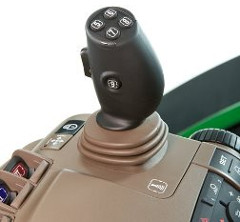 Optional crossgate joystick
Optional crossgate joystickThrottle
The throttle design incorporates buttons which control FieldCruise speed, foot pedal mode (if equipped), and transmission eco settings.
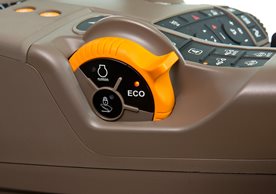 Throttle
Throttle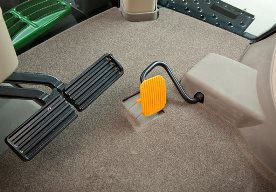 Foot throttle
Foot throttleTractor function controls
Located just to the right of the throttle is the AutoTrac activation button and four sequence controls for iTEC functions. Behind the iTEC sequence controls, there are buttons which control the activation and deactivation of MFWD and differential lock.
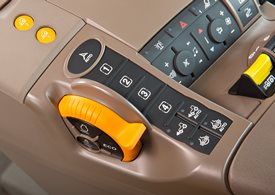 AutoTrac resume and iTEC strip
AutoTrac resume and iTEC stripControls for radio, lights, rotary beacon (if equipped), hazard flashers, and HVAC system are located to the center-right on the CommandARM, along with PTO for both front (if equipped) and rear PTO.
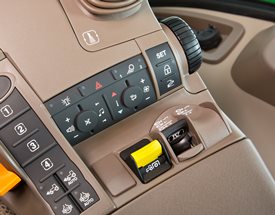 Radio, HVAC, hazard flashers, and PTO controls
Radio, HVAC, hazard flashers, and PTO controlsSeat swivel
The design of the CommandARM allows for up to 40 degrees of right-hand seat swivel.
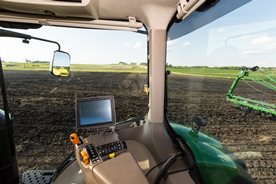 Seat swivel
Seat swivelCommandCenter
 Generation 4 CommandCenter
Generation 4 CommandCenterThe Generation 4 CommandCenter features fast adjustment of tractor functions and controls and are integrated into the CommandARM to create a seamless control center. The 4100 CommandCenter features a 178-mm (7-in.) touchscreen display and is standard equipment on 7210R and 7230R models, while the 4600 CommandCenter features a 154-mm (10-in.) touchscreen and is standard equipment on 7250R – 7310R models, as well as all 8R and 8RT models.
The following functions can be adjusted using the CommandCenter display:
- Hydraulic settings
- Hitch settings
- Transmission settings
- FieldCruise
- iTEC programming functions
- Radio
- Lights
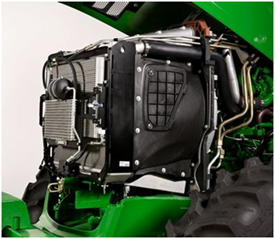 7R Series cooling package
7R Series cooling package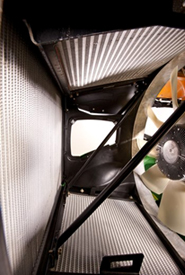 Pull-style fan and radiator access
Pull-style fan and radiator accessThe 7R Series Tractors feature an increased front area (IFA) cooling system that utilizes a pull-style fan that improves cooling efficiency over an increased surface area that provides better cooling capacity and reduces fan noise during increased power levels or while under heavy loads.
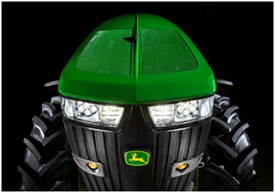 Hood screen area
Hood screen area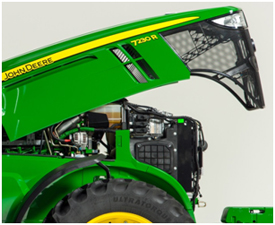 Engine hood with side shields
Engine hood with side shieldsThe 7R Series Tractors also have an increased screen area on the hood and redesigned side shields to help reduce debris buildup. The new cooling system provides easy, cooler cleanout and service accessibility without sacrifice to turning radius or front hitch and front power take-off (PTO) applications.
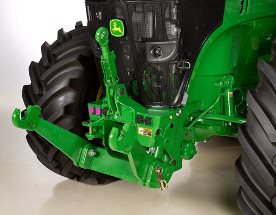 7R Series Tractor with front hitch
7R Series Tractor with front hitchThe 7R Series Tractors offer two front hitch options to best fit a variety of applications.
Standard (non-ground-engaging) hitch option for applications including, but not limited to:
- Front-mounted mowers, toppers, and snow blowers
- Carrying front seed hoppers and plow packers
- Carrying front ballast
- Operating light-draft implements
Premium (ground-engaging) hitch option for applications including, but not limited to:
- Operating primary tillage equipment and standard blades
Premium hitches include a push bar and heavier lift arms:
- Hitches with zero front auxiliary valves include one mid-mount valve.
- Hitches with one front auxiliary valve include two mid-mount valves.
- Hitches with two front auxiliary valves include three mid-mount valves.
To ensure adequate hydraulic availability, up to two selective control valves (SCVs) can be included with a front hitch.
 Joystick control
Joystick control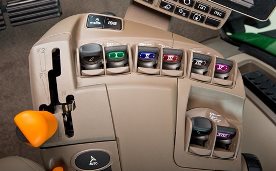 Paddle pot SCV
Paddle pot SCVTractors equipped with a factory front hitch have the option of selecting a joystick control or paddle pot SCV controls. The joystick control is not compatible with the sixth rear electrohydraulic SCV because of the CommandARM™ controls space required for the front hitch joystick.
Features of John Deere factory-installed front hitches include:
| Standard | Premium |
Lift capacity at ball ends (ISO) | 5200 kg (11,464 lb) | 5200 kg (11,464 lb) |
Lift range | 750 mm (29.5 in.) | 750 mm (29.5 in.) |
Overhang when folded | 55 mm (2.2 in.) | 55 mm (2.2 in.) |
Approach angle (depending on tire and axle setup) | 25.5 - 38.7 degrees | 25.5 - 38.7 degrees |
Reinforcing push bar | Field-installed option | Standard |
Auxiliary valve with front couplers | Optional | Standard |
Category 3N hitch | Standard | Standard |
7-pin connector - for implement lights | Standard | Standard |
9-pin harness and connector (ISO) | Field-installed option | Field-installed option |
Front-mounted remote switch | Standard | Standard |
Hitch damping | Triple-Link Suspension (TLS™) axle, same effect | TLS axle, same effect |
Hydraulic mode select | Single and dual | Single and dual |
Electronic position control | Yes | Yes |
Full ground clearance | Yes | Yes* |
iTEC™ compatible | Yes | Yes |
Power take-off (PTO) compatible | Yes | Yes |
Installed weight (with push bar)** | -- | 455 kg (1003 lb) |
Installed weight (no push bar)** | 345 kg (760 lb) | -- |
*Hitches with a push bar maintain front axle to ground clearance for row-crop applications and can be used with ground-engaging implements, including primary tillage implements and standard blades.
**Equals weight of added hitch components.
The integrated and styled compact hitch design maintains full maneuverability even with the larger front tires. The hitch extends only 55-mm (2.2-in.) ahead of the front support when the arms are folded.
Standard (carrier version) hitches can be converted to a premium (ground-engaging) hitch by ordering and field installing a conversion kit that includes push bar and heavier lift arms.
All factory-installed front hitches are capable of single- and dual-acting hydraulic cylinder modes. This allows the operator the flexibility to choose the correct mode for a variety of front hitch applications. Single acting provides hydraulic force for retracting the front hitch cylinders and allows front implements to follow the contour of the ground or surface. For example, this would be the correct mode for a front-mounted snow blower. Dual acting provides hydraulic force in retracting and extending the front hitch cylinders to provide down force for ground-engaging implements.
Additional hitch features include:
- Integrated and protected routing of oil lines
- Category 3 top link with storage position
- Integrated towing clevis with pin
- Compatible with group 42 - 44 front tires
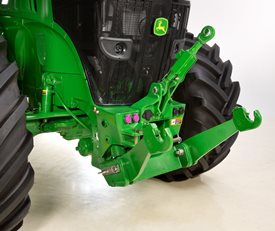 7R position sensing
7R position sensingThe 7R with front hitch comes equipped with position sensing that allows operators the ability to establish an upper height limit set point and lower limit set point through CommandCenter™ display. Position sensing maintains the height of the hitch arms based on the set points.
Position sensing provides the following benefits:
- Add to iTEC™ display sequence (raise/lower set points)
- Limit height for front-PTO implement (stay within desirable driveline angles)
- Set lower position for ground-engaging depth or blade position
- Maintain set height without added fixed link (position will auto correct)
- Prevent inadvertent hitch operation outside of desired range of motion (takes guesswork out of placing height of front implement)
- Less fatiguing for repetitive-type work where the same position is required over and over
For a 9-pin connector, order kit RE322555. The kit includes all necessary components and allows ISO implement communication.
NOTE: 7R Series Tractors with a factory-installed front hitch do not ship with a front weight support.
Front hitch – Field-installed options:
For more information on ordering a front hitch ready configuration, refer to Attachments, front hitch/power take-off (PTO) ready
For tractors ordered non-hitch or non-hitch ready please contact LaForge® company for front hitch options.
Laforge Systems Inc.
4425-C Treat Blvd. #230
Concord, California 94521
Phone: (925) 827-2010 or 1-800-422-5636
Web site: www.fronthitch.com
LaForge is a trademark of Laforge Corporation.
Front hitch options:
- Standard front hitch with zero front couplers, 5200-kg (11,450-lb) maximum lift capacity at hitch balls
- NOTE: 3150-kg (6944-lb) International Organization for Standardization (ISO) lift capacity.
Less push bar (hitch raise/lower hard plumbed to mid-mount valve)
Includes zero front auxiliary couplers.
ISOBUS connector available through Parts.
- NOTE: 3150-kg (6944-lb) International Organization for Standardization (ISO) lift capacity.
- Standard front hitch with one front auxiliary coupler, 5200-kg (11,450-lb) maximum lift capacity at hitch balls
- NOTE: 3150-kg (6944-lb-) ISO lift capacity.
Less push bar (hitch raise/lower hard plumbed to mid-mount valve)
Includes one front auxiliary couplers.
ISOBUS connector available through Parts.
- NOTE: 3150-kg (6944-lb-) ISO lift capacity.
- Premium front hitch with one front auxiliary coupler, 5200-kg (11,450-lb) maximum lift capacity at hitch balls
- NOTE: 3150-kg (6944-lb) ISO lift capacity.
Includes push bar (hitch raise/lower hard plumbed to mid-mount valve)
Includes one front auxiliary couplers.
ISOBUS connector available through Parts.
- NOTE: 3150-kg (6944-lb) ISO lift capacity.
- Standard front hitch with two front auxiliary couplers, 5200-kg (11,450-lb) maximum lift capacity at hitch balls
- NOTE: 3150-kg (6944-lb) ISO lift capacity.
Less push bar (hitch raise/lower hard plumbed to mid-mount valve)
Includes two front auxiliary couplers.
ISOBUS connector available through Parts.
- NOTE: 3150-kg (6944-lb) ISO lift capacity.
- Premium front hitch with two front auxiliary coupler, 5200-kg (11,450-lb) maximum lift capacity at hitch balls
- NOTE: 3150-kg (6944-lb) ISO lift capacity.
Includes push bar (hitch raise/lower hard plumbed to mid-mount valve).
Includes two front auxiliary couplers.
ISOBUS connector available through Parts.
- NOTE: 3150-kg (6944-lb) ISO lift capacity.
- CommandARM™ paddle pot SCV controls
- NOTE: Not compatible with joystick control.
Provides proportional paddle pot SCV control for mid-mount valve(s).
- NOTE: Not compatible with joystick control.
- Joystick control
- NOTE: Does not include mid-mount valve or loader-ready components.
ISOBUS compatible.
Not compatible with six rear SCVs.
Not compatible with CommandARM SCV controls.
- NOTE: Does not include mid-mount valve or loader-ready components.
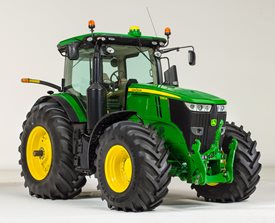 7R with TLS Plus
7R with TLS Plus
The optional TLS Plus is a fully integrated, self-leveling front suspension system available on 7R Series Tractors equipped with the 1300 mechanical front-wheel drive (MFWD) axle. TLS Plus provides exclusive front suspension using a hydro-pneumatic self-leveling system to increase productivity and improve ride dramatically. TLS Plus provides more control over the front suspension of the tractor.
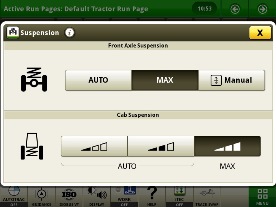 CommandCenter screen
CommandCenter screen
In the Generation 4 CommandCenter™, the operator is able to select maximum pressure to accommodate for the transfer of heavy loads with minimal front axle movement.
TLS Plus increases both transport and field productivity with superior stability, ride, and comfort. Loader operators appreciate the enhanced performance when transporting bales or a full bucket of silage. In the field, the TLS Plus front suspension maintains ground-to-tire contact, enabling more power to the ground.
The TLS Plus front axle is available with or without wet-disc front brakes. While TLS Plus is available on all 7R Series Large-Frame Tractors, it is a requirement for the following:
31-mph/50K CommandQuad™ Eco
31–mph/50K e23™
31–mph/50K infinitely variable transmission (IVT™)
TLS Plus components
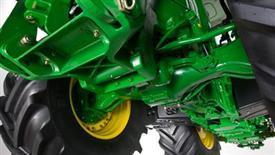 7R with TLS Plus
7R with TLS PlusTwo double-acting-control cylinders act independently or together to dampen shock loads, while supplying a constant down force on the axle for better traction. In addition to the cylinders, a pan-hard rod limits lateral motion while an electronic sensor signals a priority valve to automatically move the control cylinders as needed.
The cast driveline draft member controls fore-aft suspension of the axle. This heavy-duty conical casting encloses the entire driveline and transfers longitudinal forces to the tractor's center of gravity.
 1300 axle with TLS Plus
1300 axle with TLS Plus 1300 axle cutaway with TLS Plus
1300 axle cutaway with TLS PlusOperating characteristics:
- TLS Plus self-levels at engine start-up with the implement attached and the hitch in the raised or lowered position.
- TLS Plus self-levels whenever the tractor speed exceeds 0.9 mph (1.5 km/h).
 Automatic differential lock angle adjustment
Automatic differential lock angle adjustmentDifferential lock
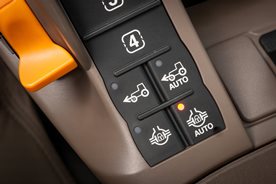 CommandARM™ controls with automatic differential lock engaged
CommandARM™ controls with automatic differential lock engaged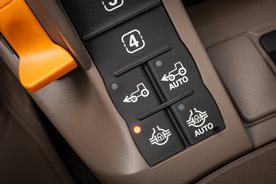 CommandARM controls with manual differential lock engaged
CommandARM controls with manual differential lock engagedThe differential lock is another feature of the 1300 Series MFWD axle with Triple-Link Suspension (TLS) PLUS, driveline shield, hydraulic on/off differential lock, and wet-disk front brakes. When the rear differential lock is engaged or disengaged, the front differential lock is also engaged or disengaged. This also includes a driveline shield.
If one wheel begins to slip, the differential lock can be engaged on the go and the axles are hydraulically locked together for maximum traction. There are two ways to engage the differential lock feature.
- Manual differential lock - differential lock can be engaged manually using a switch on the floor or by manual depressing button on CommandARM. When brakes are depressed, the differential lock will disengage
- Automatic Differential lock - when in auto mode, differential lock is engaged when the tractor is driving forward. Differential lock will disengage when front wheel turn angle meets disengage wheel angle setting defined by the operator via the CommandCenter or when either brake pedal is depressed. Differential lock will automatically engage when brakes are released or front wheels are turned straight.
The Generation 4 CommandCenter was designed to provide a consistent user experience by providing full-screen viewing of more run page modules, shortcut keys, and precision agriculture capabilities.
Expect easier set-up, along with increased operator confidence, thanks to a simple, customizable interface. The improved design of the Generation 4 CommandCenter also aids in an optimal operating experience and maximizes uptime.
In order to increase your efficiency, take advantage of the following features offered by the Generation 4 CommandCenter:
Layout manager
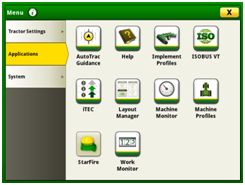 Layout manager selection page
Layout manager selection page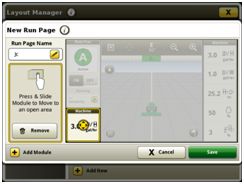 Layout manager module build
Layout manager module build- Easily create page views that meet your needs and that are also equipped with default run pages.
- Users and access allow the owner or manager to lock out certain functions to prevent operators from accessing or changing settings with a defined four-digit code.
- Gather on-screen help by selecting the help icon on the shortcut bar on the bottom of every page.
Machine monitor
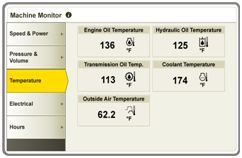 Machine monitor page
Machine monitor page- The Machine Monitor application provides you instantaneous readings about the status or condition of your machine.
- This application shows parameters such as engine speed, coolant temperature, and ground speed.
Work monitor
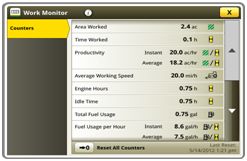 Work monitor page
Work monitor page- The Work Monitor application displays performance information about the task being performed by the machine.
- You are shown averages, totals, and productivity of the machine, such as area worked, average working speed, and fuel usage.
- Work setup places the settings needed to properly setup features such as AutoTrac, Documentation, and Section Control in a single location. Settings include:
- Client, farm, and field
- Crop type
- Machine and implement dimensions
- Variety/hybrid and planting/seeding rates
- Variable rate prescriptions
- Product and application rates
- Application rates through the implement screens
Video capability
- Machines equipped with a 4200 CommandCenter are equipped with one video input, and the 4600 CommandCenter has four video inputs.
- You have the ability to set a variety of triggers. With each trigger, the image will then appear on the display.
Flags
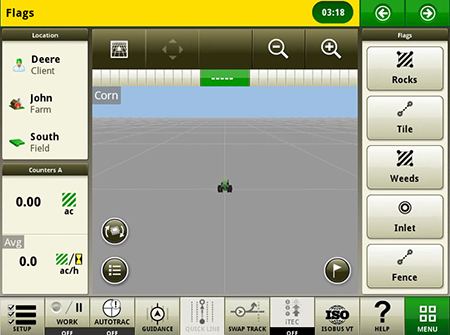 Create flags to mark items in the field
Create flags to mark items in the field- Mark areas in the field that need special attention such as rocks, tile lines, or weed pressure.
- Flags previously recorded on the Gen 4 or GreenStar™ 3 2630 Display can be transferred between monitors.
- Flags previously recorded on the Gen 4 or GreenStar™ 3 2630 Display can be transferred between monitors.
Field boundaries
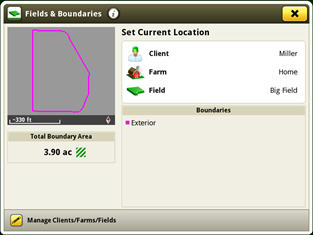 Boundary creation from coverage
Boundary creation from coverage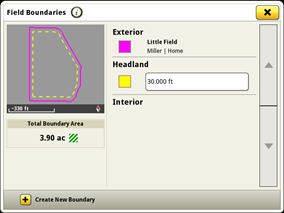 Headland creation
Headland creation- Manually drive field boundaries with the Generation 4 CommandCenter or import existing boundary information from the GreenStar 3 2630 Display or John Deere Operations Center. Gen 4 documentation data can be used to create boundaries from coverage within the John Deere Operations Center.
Dual-display mode
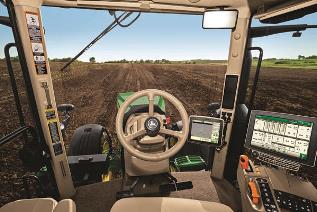 Dual display
Dual display- Generation 4 CommandCenter may be configured to run with the following John Deere displays connected at the cornerpost of a John Deere tractor:
- GreenStar 2 1800 Display
- GreenStar 2 2600 Display
- GreenStar 3 2630 Display
- 4640 Universal Display
- 4240 Universal Display
NOTE: Vehicle applications will always be located on the Gen 4 CommandCenter.
Automatic base station switching
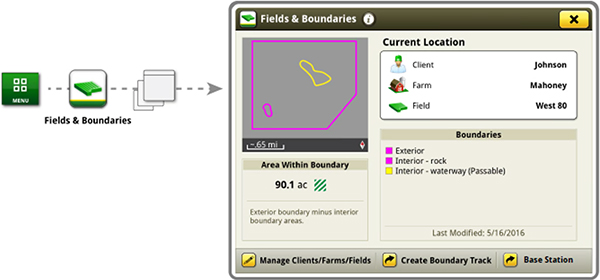 Setup base stations in Fields and Boundaries applications
Setup base stations in Fields and Boundaries applications- Customers using John Deere RTK Radio 450 or 900 can link a base station to a desired client,/ farm,/ or field. This allows automatic switching to the associated base station when changing fields. The ability to import base station assignments into Operations Center and send back to machines will be available at a later date.
Video looping supported with Gen 4 4600 CommandCenter Display and 4640 Universal Display
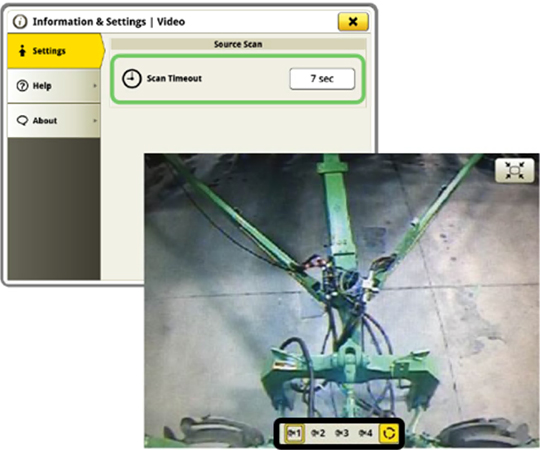 Scan through videos with video looping
Scan through videos with video looping- This feature enables users to scan or loop through all of the available video feeds for a specified duration. The default scan time is set to 7 seconds per image. The scan time is customizable per image allowing for consistent visibility to all video feeds.
Tractor-Baler Automation simplifies baling experience
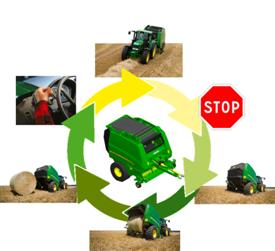 A single manual action; system manages the rest
A single manual action; system manages the rest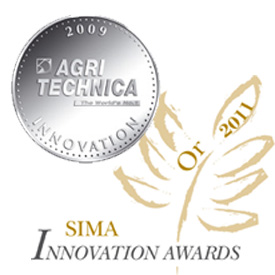 TBA awards
TBA awardsThe optional Tractor-Baler Automation (TBA) makes baling easy. This exclusive system manages most of the baling process and gives the customer the following advantages:
- High baling comfort a single action to bale instead of four.
- Error proof baling - even after 10 working hours, the system does not forget any action; a true advantage for an inexperienced driver.
- Constant bale quality - same diameter bale after bale
- Constant productivity - no reduced efficiency due to operators fatigue.
When used with a John Deere ISOBUS tractor, electric selective control valve (E-SCV), and (IVT™) transmission, the system will be able to:
- Stop the tractor when bale size is reached
- Wrap the bale
- Open the gate
- Close the gate when bale is unloaded
The only action remaining is to forward reverser and manage the steering.
If the John Deere tractor is not equipped with IVT but has E-SCV and ISOBUS, opening and closing can be automated.
A single touch on SCV, brakes, or reverser will disengage the automation. In the same way, automated open/close can be momentarily stopped when unloading in hilly conditions.
Tractor-Implement Automation is an exclusive green on green advantage. This advanced technology option has won awards at SIMA and Agritechnica farm equipment show in Europe, a true cost/value guarantee.
NOTE: to run through fully automated mode, a John Deere Isobus tractor with E-SCV and IVT is required. A baler activation key and a tractor activation key (different) have to be ordered.
ISOBUS certified balers
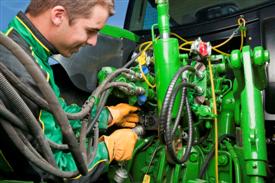 Plug in and bale with ISOBUS
Plug in and bale with ISOBUS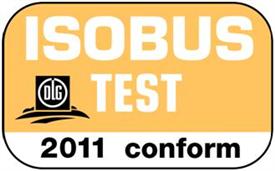 ISOBUS certified = compatibility guarantee
ISOBUS certified = compatibility guaranteeThe 990 and 960 Balers offer ISOBUS compatibility as base equipment. This standardized communication not only allows the use of John Deere Greenstar2 1800, 2600, or 2630 Displays, but also the use of other ISOBUS conform competitive monitors.
Adapter harnesses for non-ISOBUS tractors are available.
User friendly interface
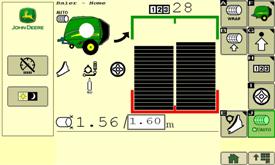 Main page with simple and clear pictograms
Main page with simple and clear pictograms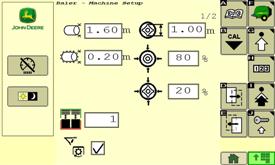 Bale or soft core density adjustments
Bale or soft core density adjustmentsThe Baler interface displays information that is needed. The 900 Series monitors provide all required information:
- Bale shape and diameter
- Drop floor and knives position
- Variable core activation
- Tying process status
- Gate position
- Maintenance status
Adjustments can also be managed from the operators station:
- Bale size and density
- Variable core diameter and density
- Net and twine tying parameters
- Knife selection
- Automated lubrication
- Tractor-Baler Automation status
- Bale counter resets
Greenstar™2 1800 has the ideal display for baling application
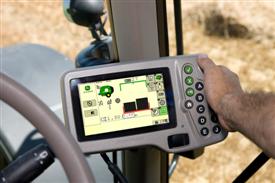 Greenstar2 1800 Display ordered with the baler
Greenstar2 1800 Display ordered with the baler
The 900 Series Balers can be teamed with all ISOBUS certified displays. The Greenstar2 1800 monitor can be ordered with the baler to match traditional baling requirements. When not baling this display can be used for other functions such as guidance and spraying applications when connected to an appropriate receiver and implement.
All ISOBUS display will fit the 900 Series
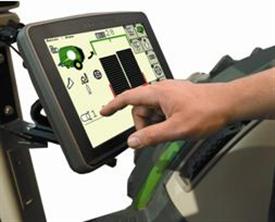 GreenStar3 2630 fits the most demanding user needs
GreenStar3 2630 fits the most demanding user needs
The 960 and 990 Balers can be ordered without a monitor for customers who already have an ISOBUS display, or for those who search more advanced application (field management). Displays other than John Deere Greenstar2 1800 can be purchased through Ag Management Solutions (AMS) pages.
Specifications
Compare the specifications of up to 4 models
| Key Specs | 7250r-tractor Current Model |
|---|---|
| Engine description | John Deere PowerTechPSS (B20 Diesel Compatible) 6.8L |
| Engine displacement | 6.8 L 415 cu in. |
| Rated engine power | At 2100 engine rpm: 184 kW 250 hp |
| Rated PTO power (hp SAE) | At 2100 engine rpm: 152 kW 205 hp |
| Transmission type | Standard: John Deere e23™ 42 km/h 26 mph John Deere e23™ Transmission 50 K 31 mph John Deere Infinitely Variable Transmission (IVT) 0.050-42 km/h (0.030-26 mph) John Deere Infinitely Variable Transmission (IVT) 0.050-50 km/h (0.030- 31 mph) |
| Hydraulic pump rated output | Standard: 63 cc: 162 L/min 43 gpm Optional: 85 cc: 222.3 L/min 59 gpm |
| Rear hitch category (SAE designation) | Standard: Category 3/3N with Quik-Coupler Optional: Category 3/3N with Hook Ends Category 3N/3 with Hook Ends |
| Base machine weight | 11,674 kg 25,738 lb |
| Maximum PTO power | |
| Maximum engine power | |
| Engine specifications | |
| Description | John Deere PowerTechPSS (B20 Diesel Compatible) 6.8L |
| Engine type | Diesel, in-line, 6-cylinder, wet-sleeve cylinder liners with 4 valves-in-head |
| Engine family | JJDXL06.8309 |
| Rated speed | 2100 rpm |
| Aspiration | Dual turbochargers, variable geometry turbo with fixed geometry turbo in series |
| Cylinders liners | |
| Emission level | Final Tier 4 |
| After treatment type | DOC/DPF |
| Displacement | 6.8 L 415 cu in. |
| Engine performance | |
| Rated power | At 2100 engine rpm: 184 kW 250 hp |
| Rated PTO power (hp SAE) | At 2100 engine rpm: 152 kW 205 hp |
| Power boost | 22 kW 30 hp |
| Engine peak torque | At 1600 rpm: 1171 Nm 864 lb-ft |
| PTO torque rise | 40 percent |
| Intelligent Power Management (available in transport and/or mobile PTO applications) | |
| Maximum PTO power | |
| Maximum engine power | |
| Transmission | |
| Type | Standard: John Deere e23™ 42 km/h 26 mph John Deere e23™ Transmission 50 K 31 mph John Deere Infinitely Variable Transmission (IVT) 0.050-42 km/h (0.030-26 mph) John Deere Infinitely Variable Transmission (IVT) 0.050-50 km/h (0.030- 31 mph) |
| Reverser | |
| Clutch; wet/dry | |
| Creeper | |
| Hydraulic system | |
| Type | Closed-center, pressure/flow compensated |
| Pump rated output | Standard: 63 cc: 162 L/min 43 gpm Optional: 85 cc: 222.3 L/min 59 gpm |
| Available flow at a single rear SCV | 132 L/min 35 gpm |
| Available flow at front SCVs | 126 L/min 33 gpm |
| Number of rear selective control valves (SCVs) | Standard: 4 SCVs Optional: 1/2 in. ISO Couplers: 3-6 0.75 in. and 0.5 in. ISO couplers: 5 (SCV 1: 0.75 in couplers, SCV 2-5: 0.5 in coupler) |
| Number of mid selective control valves (SCVs) | |
| Number of front selective control valves (SCVs) | 1 with front hitch |
| Joystick SCV control | |
| SCV control | Electronic |
| Rear hitch | |
| Hitch draft control load sense type | |
| Remote control valves available | |
| Hitch category (SAE designation) | Standard: Category 3/3N with Quik-Coupler Optional: Category 3/3N with Hook Ends Category 3N/3 with Hook Ends |
| Maximum lift capacity behind lift points | Standard (Category 3): 5984 kg 15,200 lb Optional (Category 3N): 7847 kg 17,300 lb Standard (Category 3 with Hook Ends): 6894 kg Optional (Category 3 with Hook Ends): 7847 kg |
| Sensing type | Electrohydraulic |
| Rear axle differential lock | |
| Lift capacity at standard frame | |
| Drawbar | |
| Drawbar category | Standard: Category 3 Optional: Category 3 with heavy duty support |
| Maximum vertical load | Standard: Category 3: 1837 kg 4050 lb Optional: Category 3 with heavy duty support: 4536 kg 10,000 lb |
| Rear power take-off (PTO) | |
| Type | Independent Standard: 44.45 mm (1.75 in.) 20-spline, 1,000 rpm Optional: 44.45 mm (1.75 in.), 20-spline, 1,000 rpm capable of 35 mm (1.375 in.) 540/1000 rpm 44.45 mm (1.75 in.) 20-spline, 1,000 rpm with 1.375 in. 540E/1000/1000E rpm gearcase 44.45 mm (1.75 in.) 20-spline, 1,000 rpm with 1.375 in. 540/540E/1000 rpm gearcase |
| Engine rpm (at rated PTO speeds) | 540/1000 PTO rpm at 1950 engine rpm 540E/1000E PTO rpm at 1750 engine rpm |
| PTO actuation | |
| Ground speed PTO option availability | |
| Multispeed PTO option availability | |
| Front hitch | |
| Category | Category 3N, ground engaging |
| Electric power | 7-pin connector |
| Standard lift capacity | 5,200 kg 11,464 lb |
| Front power take-off (PTO) | Available Optional: 44.45 mm (1.75 in.), 20 spline, 1,000 rpm, counter-clockwise rotation (when facing PTO) 35 mm (1.375 in.) 21 spline, 1,000 rpm, counter-clockwise rotation (when facing PTO) 35 mm (1.375 in.) 6 spline, 1,000 rpm, counter-clockwise rotation (when facing PTO)** |
| PTO speed | 1,000 PTO rpm at 1940 engine rpm |
| Rear axle | |
| Type | Standard: Rack-and-pinion or flange axles Optional: Diameter: 110 x 2550 mm 4.33 x 100.4 in. Diameter: 110 x 3010 mm 4.33 x 118.5 in. Diameter: 120 x 2550 mm 4.72 x 100.4 in. Diameter: 120 x 3010 mm 4.72 x 118.5 in. 335 mm (13.2 in.) Flanged Axle |
| Final drive type | Inboard planetary three pinion |
| Differential controls | |
| Axle type | |
| Brakes, type and control | |
| Rear differential lock | Full-locking electrohydraulic |
| Load rating | |
| Front axle | |
| Type | Standard: 1300 Series MFWD: tread range 1524 to 2235 mm 60 - 88 in. Optional: TLS: Tread range 1524 to 2235 mm TLS with front brakes, available with 40 kph, standard with 50 kph |
| Front axle differential lock | 1300 Series MFWD: Limited Slip TLS: Limited Slip TLS with front brakes: Full-locking electrohydraulic (actuated at same time as rear diff lock) |
| Load rating | |
| Tires | |
| Front | RCI Group 42/43/44 |
| Rear | RCI Group 47/48/49 |
| Wheel tread range | |
| Turning radius with brakes | 380/85R34 group 42 tires at 60 in. spacing 1300: 7 m 23 ft 600/70R30 group 43 tires at 74.1 in. spacing TLS: 6.7 m 22 ft 620/75R30 group 44 tires at 82 in. spacing, TLS: 8.7 m 28.5 ft |
| Turning radius without brakes | |
| Steering | |
| Electrical system | |
| Alternator size | Standard: 200 amp Optional: 240 amp |
| Battery options | 12 V |
| Total cold cranking amps | With 2-925 CCA group 31 batteries: 1850 CCA |
| Type of bulb in beacon (Halogen, Zenon, LED) | |
| Type of bulb in headlight (Halogen, Zenon, LED) | |
| Working lights | |
| dB(A) rating for backup alarm | |
| Operator station | |
| Rollover protective structure, OOS | |
| Seat | Standard: ComfortCommand™ Optional: ActiveSeat™ |
| Cab suspension | Optional: Adaptive Hydropneumatic Cab Suspension Plus (Adaptive HCS Plus) |
| Instructional seat | Standard |
| Display | 10-in. CommandCenter Display with 4600 processor |
| Radio | Standard: AM/FM stereo with weatherband, remote controls, auxiliary input jack, four speakers and external antenna Optional; Premium: AM/FM stereo with premium tuner, weatherband, remote controls, USB port and auxiliary input jack , BlueTooth capable including microphone, four speakers, subwoofer, and external antenna |
| Inner cab volume | 3.597 m3 127 cu ft |
| dB(A) rating | |
| Cab glass area | 6.52 m2 70.18 sq ft |
| Front visibility | |
| Safety glass rating | |
| Dimensions | |
| Wheelbase | 2925 mm 115.2 in. |
| Overall length | 5540 mm 218 in. |
| Drawbar clearance | Group 47 rear tires: 360 mm 14.2 in. Group 48 rear tires: 415 mm 16.3 in. Group 49 rear tires: 461 mm 18.1 in. |
| Front axle center | |
| Approximate shipping weight, Open;Cab | |
| Overall height | |
| Weight | |
| Base machine weight | 11,674 kg 25,738 lb |
| Maximum ballast level | SAE PTO hp: 145 lb |
| Maximum permissible weight | |
| Capacities | |
| Crankcase oil volume | 26 L 27.4 U.S. gal. |
| Fuel tank | e23 (G47/48): 465 L 123 U.S. gal. e23 (G49): 488 L 129 U.S. gal. IVT (G47/48): 520 L 137 U.S. gal. IVT (G49): 543 L 143 U.S. gal. |
| Diesel exhaust fluid (DEF) tank | 23 L 6 U.S. gal. |
| Cooling system | 39.5 L 41.75 qt |
| Transmission-hydraulic system | 160 L 42.3 U.S. gal. |
| Serviceability | |
| Interval for engine oil change | 500 hours |
| Interval for hydraulic/transmission oil change | 1,500 hours |
| Interval for engine coolant change | 6,000 hours |
| Loaders | |
| Loader | H480 |
| Lift capacity at full height | 2411 kg 5315 lb |
| Maximum lift height | 4704 mm 185.2 in. |
| Precision AG | |
| Guidance | AutoTrac Ready |
| Telematic | JDLink |
| Remote diagnostics | ServiceADVISOR remote: available with JDLink™ hardware and activations Remote Display Access: available with JDLink™ hardware and activations |
| Miscellaneous | |
| Country of manufacture | USA |
| Side slope rating | |
| Uphill/downhill slope rating | |
| Tracks | |
| Drive type | |
| Midrollers | |
| Track width | |
| Tread spacing |













